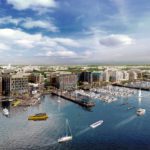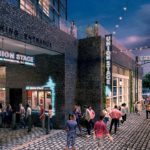RISING TIDES How the Wharf Is Set to Redefine D.C.
By • July 12, 2017 0 1881

Phase 1 of the Wharf, the multibillion-dollar project springing up from the Southwest waterfront, is set to open Oct. 12. PN Hoffman’s Monty Hoffman couldn’t be more excited for Washingtonians — and the world — to see what his firm, co-developers Madison Marquette and their team of planners, architects, builders and other partners have painstakingly pulled together over the past decade.
His confidence in the brand-new, mile-long neighborhood’s appeal is contagious.
“This project is about D.C. breaking out of its parent-child relationship with the federal government and forming its own identity,” Hoffman says. “It’s the one place in the DMV [D.C.-Maryland-Virginia] region where we can embrace the water in a much grander way.”
To your average D.C. commuter who — while idling for hours on I-395 — has witnessed the Wharf transform from a giant pit in the ground to a cluster of gleaming high rises, Hoffman’s vision may sound lofty, or even out of touch. After all, given Washington’s history with big, flashy (not to say overhyped) developments, the Wharf may feel a bit like déjà vu all over again.
In Georgetown, Washington Harbour typifies the trend, delivering prime waterfront retail and restaurant space but in the form of a Brutalist castle. More recently, CityCenterDC has been the development poster child. Despite occupying an ideal central location just north of Chinatown, its mix of high-priced retail and restaurants is shunned by many locals. Or take National Harbor, a riverside behemoth that, with the opening of the $1.3-billion MGM casino resort, largely serves gamblers and conventioneers.
The Wharf is on a similar scale. Phase 1 comprises roughly two million square feet of mixed-use development. 655 apartments, some of which will be “micro-units” intended for transient millennials, are spread across three high-rise buildings. Two state-of-the-art office buildings together account for more than a half-million square feet of office space.
Phase 1 alone is imposing, and another million square feet are coming in Phase 2. But Hoffman insists that the Wharf is unlike any other recent D.C. development. “The difference,” he argues, “comes down to curation.”
IT COMES DOWN TO CURATION
From the beginning, Hoffman and his team set out to make a neighborhood that felt genuine and local. “We were very careful about how we curated the businesses, and we worked to bring in the right tenants to achieve their vision,” he says.
Their recruitment efforts pulled in some big fish with significant cultural cachet in the area.
First, they linked up with 9:30 Club and I.M.P. Productions owner Seth Hurwitz, who had been looking at locations where he could create a distinctive music venue. The result of their collaboration: the Anthem, a new $60-million, 6,000-capacity venue that will anchor Phase 1 of the Wharf.
The Anthem will have everything music fans want, including state-of-the-art sound and killer views. Located in a larger mixed-use building (fear not, residents, there will be excellent soundproofing), the venue will take advantage of at least one building amenity: two rooftop pools. The pools’ glass bottoms will act as luminescent skylights for the venue below (fear not, ticketholders, you won’t get wet — or see residents swimming above, we think).
Hurwitz booked the Foo Fighters, fronted by area native and Black Cat co-owner Dave Grohl, to ring in the Anthem’s inaugural — and already sold-out — show on Oct. 12. “There was never any question about who would open. There was no Plan B,” Hurwitz told the Washington Post. The lineup for later this year and early 2018 includes international pop star Lorde and indie darlings LCD Soundsystem, who just reunited after a seven-year hiatus.
The Anthem is one of three (and counting) music venues at the Wharf. Another, Union Stage, is coming courtesy of Daniel, Luke and Jonathan Brindley, owners of the Vienna, Virginia, venue and café Jammin Java. Over the years, the brothers have had a number of offers to open another venue, but haven’t taken one up until now. “They found us,” Daniel Brindley says of Hoffman’s team, “and we were sold immediately.” He reiterates the importance of Hoffman’s curation, noting that the developer “doesn’t just pick anyone” to partner with at the Wharf.
Union Stage will be the “perfect counterpoint” to Jammin Java, says Brindley, who books shows both for Jammin Java and for the new venue. “We made something in the suburbs that honestly shouldn’t have worked. But it worked and now we get these amazing rock bands that come through.”
While he doesn’t know exactly what the mix at Union Stage will be — it won’t open until later this year and, he says, “venues take on lives of their own” — he’s excited about being able to offer musical acts that will bring in urban listeners, from hipsters to hip-hop fans. “The urban location opens up that whole world of musicians,” he says. The venue will offer seated and standing shows, so classic rockers can enjoy an acoustic set comfortably, young pop fans can dance the night away and Brindley can book a diverse array of bands and singers to fill the house.
Union Stage will hold 400 concertgoers, double that of Jammin Java, and offer a comprehensive menu from its full kitchen. The venue is located on Pearl Street close to the Anthem and Pearl Street Warehouse, another bar with a live music venue. Brindley doesn’t seem concerned about the competition. “Rising tides lift all boats, and there’s a way to compete and still be friends,” he says. “Pearl Street is always going to be a thing, like, ‘Meet you at Pearl Street!’”
Deliberately narrow, the cobblestone street will be dotted with restaurants and bars. After 5 p.m., Pearl Street will close to car traffic, becoming a pedestrian-only thoroughfare. (There is parking nearby, but underground and out of sight.) Union Stage will have a nondescript cellar door and a basement-club vibe, the way Brindley likes it.
FOOD-SCENE HEAVY HITTER
Music isn’t the only attraction at the Wharf. Heavy hitters in the D.C. food scene will be represented too. James Beard Award-winning chef Fabio Trabocchi will be there at Del Mar, a bi-level waterfront seafood restaurant where the menu and ambiance will pay homage to the Spanish island of Mallorca. D.C.-based celebrity chef Mike Isabella is set to open Requin, a French Mediterranean restaurant with waterside seating on the end of District Pier.
Mainstays like Dolcezza Gelato and hoagie-purveyor Taylor Gourmet will also be on hand. Southwest deck bar Cantina Marina will bring its combination of easy drinking and easy listening to the Wharf, and Todd Thrasher, owner of Alexandria cocktail bar PX, will open a two-story rum distillery and tiki bar called Potomac Distilling Co. Did someone mention oysters? The ever-expanding Hank’s Oyster Bar will operate Hank’s on the Water and the early-20th-century oyster shed at the Municipal Fish Market will, fittingly, house Rappahannock Oyster Bar, run by the Croxtons, a Virginia oyster-farming family.
As for the tenants for the Class A and trophy-class office space, Hoffman name-drops a few examples: Washington Gas, the American Psychiatric Association and the intellectual-property law firm Fish & Richardson.
The top firms, fancy restaurants, cocktail bars and music venues may seem geared to the affluent, but Hoffman maintains that there’s something at the Wharf for everyone. The condos and apartments come in a range of sizes; according to Hoffman, some will be affordable enough for people who work at the Anthem or the nearby restaurants to live in.
A local cruise company will run water taxis from Georgetown, Nationals Park, Old Town Alexandria and National Harbor, adding to the Wharf’s accessibility for D.C.-area residents and visitors. “The Wharf will be a big part of the city’s offering to the 5.5 million people in the region, and to the 18 million people who visit the District annually,” Hoffman says.
The way Hoffman sees it, his company has turned barely used federal land into a huge cultural and economic asset for the city. Foo Fighters concertgoers — and other early arrivals — should plan to dine out, bar hop and explore the neighborhood, he says. In person, they’re likely to be astounded by the city-in-a-city that they have watched rise on the Southwest waterfront. And there’s more to come: Phase 2 construction will get underway in April of 2018.
- Monty Hoffman stands in front of the newly constructed Anthem. Photo by Neshan H. Naltchayan.




